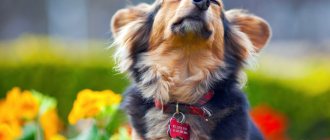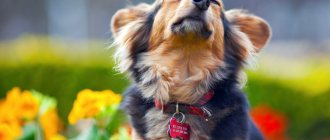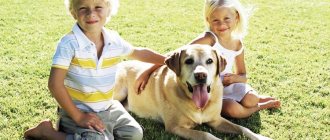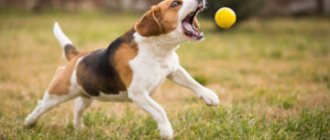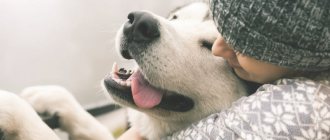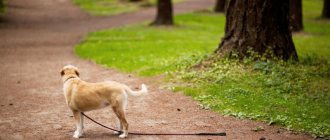When purchasing a pet, it is important not to forget about further responsibility for its life. The situation when there is a dog and a child in the house at the same time deserves special attention.
Placing all care and maintenance concerns on the latter is not the best idea. You need to approach this moment gradually, and before it you will have to seriously think about choosing your future pet. After all, not all four-legged animals are ready to put up with children's screams and pranks.
Pet: to have or not?
First of all, let's figure out whether it is worth getting a pet if there is a child living in the house. On the one hand, animals are wool, dirt and unsanitary conditions, which do not please everyone, on the other hand, there are unconditional advantages of communication between a child and a pet:
- caring for an animal develops in a child a sense of responsibility for his actions and the ability to empathize;
- pets facilitate the process of socialization: the feeling of having a four-legged friend increases self-esteem, develops communication skills and allows you to believe in yourself;
- Scientists at the University of Florida conducted a study, the results of which showed that pets provide children with moral support and effectively relieve stress.
But in order to experience the listed benefits, you need to take all possible precautions and devote more than one hour to training.
Collie
This is a very smart, gentle and devoted animal that will get along well with a child of any age. Due to its developed intelligence, the dog is highly trainable, so if your child is involved in raising it, then the cute puppy will grow into a devoted, well-managed and obedient friend.
Collies are very hardy, which means that your child will be able to play with the dog until he gets tired, especially since the dog likes it. Representatives of the breed are characterized by a long coat, which needs to be looked after, but this will certainly not be a burden for the little owner - the collie will make you fall in love with it from the first meeting!
Small child and adult dog in the house
One of the most common situations that causes concern is the appearance of a baby in a family that already has a dog (sometimes a large one). How to avoid jealousy, fear and aggression from a dog towards a child?
- Normal mode. According to private animal psychologist and dog handler Yulia Mysheva, any change in the family is stressful for the dog, which can result in damage to objects, excessive activity and deteriorating cleanliness. To calm your dog down, show him that he is still loved: continue to walk the animal, play with him in the same way as before the birth of the child. Do not disturb the established order: do not change the daily routine, workload, furnishings in the house, do not drag the lounger to another room.
- Educational games. Various puzzles and search games for dogs will help make adaptation to a new creature in the house easier. They help develop thinking and provide sufficient exercise for the animal. For example, you can wrap food in wrapping paper, hide it in a box, and the dog’s task is to find the hidden treat. Pyramid or ball puzzles are also good options.
- Acquaintance. Expert of the Russian Canine Federation, dog handler and zoopsychologist Vadim Korshunov warns that the adaptation process will be easier if the dog has already had experience interacting with small children. In this case, the appearance of a child in the house will not cause stress. When the baby arrives, you need to let your pet sniff him - this way they will get to know each other.
- Training. The dog must be obedient and controllable; for this it is recommended to train it from childhood. Dog trainer Yulia Mysheva recommends mastering such distracting commands with your animal as “come to me,” “to your leg,” and “lie down.” For example, a situation may arise when a mother is holding a baby in her arms, and at the same time the dog is climbing towards her, demanding attention - in such cases, distracting commands work best. It is very useful to teach an animal to control its emotions and relax. Teach it the “calm down” command so that it understands that the situation is not dangerous.
Bernese Mountain Dog
The character of this dog, which became popular after the airing of the series “Happy Together,” gives every reason to call the Mountain Dog the best family breed. Due to their sociability and kindness, as well as due to their “farming” nature, dogs become excellent nannies and shepherds for “these human fools.”
No, the mountain dog will not rush after your prankster’s skateboard - for this the dog is a little lazy, but “herding” and guarding your baby in the backyard is the highest pleasure for it.
Buy a puppy for a child
Vadim Korshunov advises parents with a child who are planning to get a puppy to wait until the baby is at least two years old. Until this age, he is active enough to harm the animal, and not conscious enough to protect himself. Of course, you need to pay careful attention to the choice of breed. Preference should be given to calm dogs that are not prone to aggression. Ideal options: golden retriever, labrador, poodle. To this list Yulia Mysheva adds French bulldogs, livery dogs, shih tzus, pugs - they are calm and moderately playful.
The zoopsychologist is sure that the priority should not be the breed, but the upbringing. If you train the animal and instill in your child a culture of communicating with a dog, almost any breed will do. Despite existing stereotypes, even Pit Bulls and Staffords turn out to be quite friendly and self-controlled if properly trained.
You should be wary of breeds such as Chihuahua, Spitz, Pekingese and Pinscher. Despite their charming appearance, they have a rather obstinate disposition, with which they compensate for their small size and helplessness. Such dogs can scare and even bite a baby. On the other hand, they themselves are at risk, as they may be accidentally injured by the child. It should be remembered that any dog can theoretically cause harm to the baby, so communication should occur exclusively under the supervision of adults.
Beagle
The Beagle is another ideal dog for a child. She loves playing together, so your child will not be bored in her company. Distinguished by their sociable disposition and mobility, beagles are, however, very calm.
Read Black dogs - 20 breeds with names and photos
They love affection, so the beagle can become an enviable nanny for kids. But older children will also be interested in a pet that is well trained and obedient.
If you don’t like your dog to sleep with your son or daughter in the same bed, you need to accustom your beagle to this as early as possible - the dog is stubborn in its love for its little owner (although, as experience shows, 50% of pets sleep in bed with their owners , even if the first ones are against it).
Dog and child: how to ensure safety?
Drastically changing the layout of the house is harmful for the dog, but you can put a barrier on the door to the room where the child is. This will make life much easier for the mother, who will not have to constantly monitor the situation.
Many parents are concerned about allergies that their children may develop. According to Yulia Mysheva, communication with a dog, on the contrary, strengthens the immune system. This is confirmed by the results of a study conducted by scientists from the Department of Pediatrics at the University of Wisconsin. It turned out that dogs really influence the rapid development of immunity in a child - children who lived with dogs in the same house from infancy were half as likely to suffer from atopic dermatitis and wheezing when breathing by the age of three.
There are several ways to reduce exposure to irritants. So, you should regularly groom your dog, comb it more often, regularly clean and wash the floors to minimize the amount of hair in the apartment.
Strengthens immunity
The dog brings dirt from the street on its fur and paws, which is useful for the baby’s immunity, since these factors form the necessary microbial load - constant and adequate. And the sterile environment that parents try to create for the child, on the contrary, contributes to the occurrence of allergies.
Contraindications exist only for children with breathing problems, allergic edema and asthma.
This does not mean that you need to forget about your pet’s hygiene, but you should not deprive your child’s immunity of the necessary stress.
Aggression from the animal. How to avoid it?
First of all, you should explain to your child what role the pet plays in the house. Talk about not being rude to the animal, waking it up, disturbing it, feeding it inappropriate food, or shouting loudly in its presence. It is important to demonstrate respect and tenderness for the animal by example - this way the child will quickly understand how to behave. Advise that it is dangerous to approach an animal that is eating or sleeping.
If unreasonable aggression occurs on the part of an animal, dog handler Vadim Korshunov advises that you must punish the animal and let it understand that such behavior is unacceptable. If it is not possible to change the animal’s behavior, it is better to seek help from an animal psychologist, since dog handlers mainly train and cannot always solve the problem.
To avoid aggression from an animal outside the home, warn your child that an unfamiliar dog is a big risk. Yulia Mysheva told what to do when meeting a strange animal: “You don’t need to shout at the dog, wave your arms in front of it, or approach it sharply. If your dog growls, don't panic or run away. Turn sideways to the dog and walk around him in an arc.”
German Shepherd
This incredibly loyal dog is simply created to protect your baby. She is distinguished by her enviable friendliness and desire to protect her family. If you train your shepherd correctly and spend enough time outside with it, the dog will respond with unparalleled dedication and become a true friend for your child.
It is interesting that the shepherd is not only one of the kindest breeds, but also the most reasonable of all. Before committing this or that act and deciding on something, an animal will think a hundred times. Therefore, if a dog decides to attack a person who, in its opinion, is dangerous for the owner, there is hardly any doubt about the advisability of this.
Parents should remember that:
• Dogs are not capable of fulfilling the social orders of people, so owners should know and understand the laws of the pack by which the dog lives, and teach the child to understand these laws. The dog should firmly understand from childhood that in your family, in terms of status, it occupies a lower position.
• Young children should never be left alone with even a well-established dog.
• You should constantly monitor the process of play and communication between the child and the dog. If you see that your dog is unhappy with playing with your child and is trying to get away from him, intervene and stop him! You need to anticipate problems before they actually arise.
• When raising a puppy, you should avoid and do not allow children to play games with the puppy that have elements of confrontation (wrestling), rivalry over the possession of some object (“tug of war”), as well as “hunting” games. Having become accustomed to such games, the dog may subsequently, without wanting anything bad, behave rudely with the child or injure him in the game.
• In most cases, children should not walk their dog unless accompanied by an adult. The general rule is that if the dog's weight is more than one-fifth the child's weight, the dog is too large for the child to walk independently.
• If you have children in your family and the dog gets along well with them, still always keep your dog’s interactions with other people’s children under control. You can never be sure how a dog will react to the behavior of someone else's child. Conversely, other people's children may not know how to properly behave with a dog.
• Protect your dog and supervise children he comes into contact with. If children regularly bully your dog, it will not love them. If the child does not want to be kind to the dog, either take the dog away or remove the child.
• If your dog growls at a child, seek help from a qualified dog trainer immediately. Aggression in dogs does not go away on its own.
Labrador Retriever
This is a textbook breed of dog for the whole family. The Labrador is friendly towards children and behaves very calmly around them. Even if your baby is capricious, the dog is unlikely to show intolerance towards him. Moreover, she will be happy to tinker with him and participate in his fun.
For an older child, a Labrador will also be very interesting. Thanks to their outstanding intelligence, dogs of this breed are easy to train, so following commands will bring great pleasure to both the pet and its little owner.
Thanks to the developed parental instinct, a representative of the breed can become a wonderful nanny who will always be on the alert if something threatens the child.
What you should teach your children
• Children should be strictly prohibited from hitting the dog or doing anything that will be painful or unpleasant for the dog. Although some dogs will tolerate anything from people, this cannot be expected or required of every dog. Don't let your child do things to your dog that you wouldn't let him do to another child.
• Children should be prohibited from approaching the dog when it is eating, much less taking food from the dog.
• Children should be taught that they should never suddenly approach even a well-known dog without first talking to it and making eye contact.
• You cannot suddenly lean toward a lying dog, step over it, or sit on it.
• Children need to be taught that under no circumstances should they chase a dog or try to grab it.
• Children must be taught the “language” of dogs, that is, explain how a dog outwardly expresses certain feelings. This must be done to ensure that the child does not approach a dog whose appearance demonstrates aggression, fear, or oppression.
• Children should be taught not to move quickly, shout or make sudden movements in the presence of a dog, even if it is on a leash. You cannot run from a dog and look at it closely.
• Children should be prohibited from approaching dogs during their courtship period, a bitch with puppies, or a sick dog.
• Children should not be allowed to approach unfamiliar dogs, much less try to pet them. If a strange dog is walking with its owner, you should always ask permission before approaching it.
Poodle
The poodle is not only distinguished by great intelligence and loyalty, but is also not at all averse to playing with children. He willingly learns everything new, so he becomes a well-mannered and well-managed dog who will never throw out his knees. For this reason, the poodle is completely safe even for the smallest.
With older children, the poodle will spend time outside endlessly - he loves walks with his little owners. It is interesting that this dog loves to perform funny tricks every now and then, which delight the whole family.
Waiting for a baby
If you already have an adult dog and you are expecting a baby, try to prepare your pet in advance and as seriously as possible for the arrival of the baby. Even the kindest dog, not knowing how to behave correctly in changed conditions, can cause you a lot of trouble in this situation. Before a child arrives in the family, think about how your life will change with his arrival. Imagine how a dog will behave towards a baby. If you foresee possible problems, address them without delay.
So what changes in your relationship with your dog need to happen before you have a baby?
• Establish a reasonable and clear daily routine for your dog that will be established with the arrival of the baby, and stick to it consistently. This schedule includes time for walks, games, meals, etc. A dog that lives according to a set daily schedule and has sufficient exercise will not experience feelings of competition, anxiety, or require additional attention from you.
• Limit the amount of attention you give to your dog in your free time. In this case, after the birth of the child, when you can no longer pay much attention to the dog, radical changes will not occur in its life. Otherwise, when your attention suddenly turns to him with the birth of the child, it will be unfair to the dog and create conditions for jealousy and rivalry.
• Teach your dog to earn his living by performing certain duties. You should teach her that she can get all the good things only by obeying you. If the dog is allowed to do whatever he wants, this will lead to bad behavior, because he will begin to think that you live solely to serve him.
• If your dog loves to lie on the sofa or bed, and you do not forbid it, then now is the time to change the right to use the furniture. Soon your baby will be dozing on the couch or lying on the bed. To avoid trouble, train your dog to stay on the floor until he is invited onto the sofa or bed.
• It would be right if you get a crate (or find a special place in the house) and teach your dog to spend a certain amount of time there. In this way, you will provide the dog with privacy and guarantee the safety of the child, who will not be able to pester the dog in your absence.
• Watch what you say. Your dog takes you literally. If throughout his life he heard the words “What a good boy!” addressed to him, and always when these words were spoken, he came up to be stroked or scratched behind the ear, now, when you say such words, addressing your son , don’t be surprised if the dog tries to stick its muzzle between you and the baby. To avoid such situations, come up with a few phrases that are intended only for the dog.
• Stop violent play in the house. A dog chasing a ball can jump on anything and anyone. It is better to move all outdoor games in which the dog must fetch different objects to the street.
• Never play aggressive or competitive games with your dog. By using such games, you can unknowingly teach your pet to behave aggressively while playing.
• Purchase children's toys in advance and train your dog not to touch them. This will help you save yourself stress in the future.
• If possible, show your dog to children in advance. Many dogs, if they have not previously encountered children, do not know how to behave around them. If you notice that your pet is not responding well to the presence of children, seek help and advice from a professional trainer.
• Do not remove your dog's collar and leash for the first few weeks after the baby arrives at home. This will help you quickly stop your dog if he begins to behave in an undesirable manner.
Over time, as your pet gets used to having a baby in the house, you should associate the baby's presence with some extra attention towards the dog. For example, when entering a child's room, talk to her more kindly, treat her more warmly when she is next to the child.
• A child should be taught from childhood to behave correctly with a dog!
Welsh Corgi
This breed previously served humans as a shepherd and watchman. Its representatives are very friendly, full of love for life and positivity. They love to communicate with children and obey their commands, the set of which, thanks to the high intelligence of the animal, can be very wide.
In relation to the youngest members of the “pack”, corgis behave as guardians and protectors. Feel free to go about your business - the dog will not take his eyes off your little fidget.
Cautions
• Never leave even the kindest and calmest dog alone with a baby. If you are not sure that the dog will not be able to get into the nursery in your absence, it is better to lock it or tie it.
• Do not force the dog to communicate with the child. This will put her in a position where she will feel trapped. A dog in such a situation can either run away or fight.
• The appearance of a baby in the house is perceived well by most dogs, so it is likely that with your continued participation and control over both of you, you will not have any troubles.
However, there may be exceptions in any breed, and if you notice that the dog is negative towards your child, deliberately avoids him or growls, immediate action should be taken. It is very serious! Seek professional help. Do everything you can, but in the end, if the dog's attitude towards the baby does not change, find a new home for the dog.
WHAT COLLAR SHOULD YOU CHOOSE FOR YOUR DOG?
HOW DOGS COMMUNICATE WITH EACH OTHER
HERPENTING AND CATTLE BREEDS OF DOG
Is there a breed limit?
Not all dogs and children are compatible. Avoid already trained guard dogs, representatives of fighting breeds and overly nervous animals that cannot tolerate loud noises and increased attention.
IMPORTANT!
Do not take your baby a mongrel from the street or an animal from a shelter. Due to their difficult fate, such pets are more difficult to train and may show cowardice or aggression.
The safest option is breeds that are good natured, patient and obedient. These include retrievers, setters, poodles, St. Bernards and German shepherds.
“ Read more: TOP 50 dog breeds for families with children
Pug
This little dog hides a significant personality. A good companion on children's walks, the pug gets along with both kids and teenagers due to its affectionate, friendly and playful disposition.
If your child is a homebody, feel free to get him a calm pug, with whom he does not need to go for long walks in any weather. The dog will keep company in children's games, every now and then sneezing, snorting, snoring and making other funny sounds that children are delighted with.
Jack Russell Terrier
This little “jumper” and merry fellow is known all over the world for the comedy “The Mask”. The dog will conquer any child's heart with its cheerful disposition and cheerfulness. This is unbridled energy - its surge will surprise even the most explosive fidget who cannot be kept in place.
Read Dogs for hunting - top 20 breeds
It is possible that such a tandem will cause a local disaster in your apartment, but the child’s emotions are worth it! He will be able to endlessly run and jump on the street to the cheerful squeals of his four-legged Energizer.
Jack Russell is a great opportunity to teach your child to go jogging in the morning. The pet will go crazy from such joint activity.
Irish Setter
Your child will show off his charge during a walk, because the setter would probably win a beauty contest among its relatives. You just want to touch his stunning fur, and the elegant gait of an exquisite hunting breed speaks volumes about his noble disposition. Thanks to its good-natured disposition, the setter is loved by the entire family.
An active junior schoolchild or teenager will definitely appreciate the “fiery” nature of this dog - this ball of energy literally ignites as soon as it gives free rein to its movements, its endurance and speed. Walking with these intellectuals and good-natured people is a pleasure.
Saint Bernard
Although the St. Bernard is a large and heavy dog, it has legendary fame behind it. These are rescue dogs, heroes who have pulled many people out from under the snow. Saint Bernards love children very much and, like real Dogs with a capital D, they are not offended by their children's antics.
Since the breed has distinct humane breed characteristics, its representatives will be happy to become part of your family and a nanny for your kids. It is interesting that the St. Bernard will never wake up his little charge by barking - he does this only as a last resort.
Hungarian Vizsla
Although the name of the breed is not on everyone’s lips, this is completely undeserved, because its representatives get along perfectly with children. The Vizsla is a loyal, affectionate, soft and very friendly animal.
Training it for your child will be a pleasure, since the dog grasps everything on the fly, and raising it is not at all a burden. The Vizsla enjoys frolicking in the company of children and loves the whole family, whose devotion knows no bounds.
